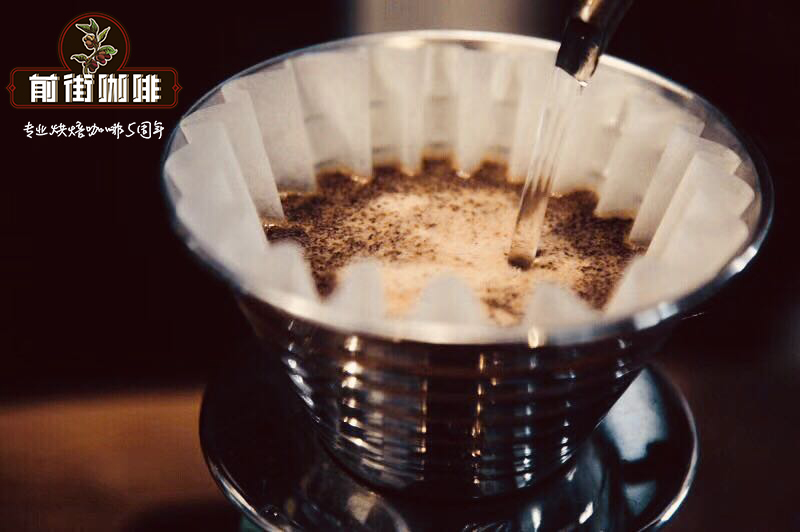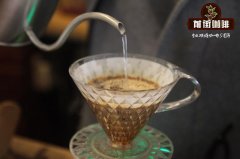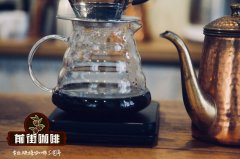Skills and proportion of hand-brewed coffee how to drink a cup of sweet and sour coffee that belongs to you?

Professional coffee knowledge exchange more coffee bean information please follow the coffee workshop (Wechat official account cafe_style)
Hand Coffee course _ hand Coffee Video _ skills and proportion of hand Coffee
The first impression of hand-brewed coffee is probably the most accessible coffee utensils, but in fact it is no less complex than siphons and Italian coffee machines, with a wider range of factors and multiple variations. professional coffee lecturers analyze all kinds of utensils needed to brew coffee by hand to brew skills one by one, so that you can rush out of leisure and taste.
Deep or shallow baking determines sour and bitter.
In the selection of coffee beans, deep roasting and shallow roasting is the biggest distinction, shallow baked beans are mostly with fruit-like sweet and sour aroma, while prefer chocolate bitter sweet flavor, you can choose deep-roasted coffee beans. Lightly roasted coffee beans taste sour, and in the past they were thought to be more difficult for Taiwanese consumers to accept, but in fact, the quality and cooking methods of coffee beans are mixed. Huang Lin-chih points out that good shallow baked beans are "sweet and sour" rather than "sour," and there are many supporters.
Coffee beans are divided into single beans and formula beans, in which formula beans are based on the concept of "truncating long points to make up for weaknesses", mixing several coffee beans to create the taste and taste of coffee, there is no absolute good or bad, only suitable or not suitable, the best way is to order a cup in the store before buying, confirm your preferences and then do it.
Coffee beans are kept at room temperature and sealed
Buy roasted coffee beans to take home, it is recommended to put them in ventilated but sealed containers, such as now most market stores will be packed in sealed bags with one-way exhaust valves, which is the best way of storage. shallow roasting and deep roasting will cause different dehydration rates of coffee beans, and the shelf life varies from three to four weeks.
Coffee beans are best preserved at room temperature. Cold storage or freezing may cause damage to the texture due to changes in temperature or the crystallization of water contained in coffee beans, and the fiber inside coffee beans has the characteristic of adsorbing flavor, which is placed in a refrigerator with high relative humidity. It is easy to absorb the taste of other foods, but become a super deodorant.
The powder of electric bean grinder is more uniform.
Due to budget considerations, most people will consider starting with a hand-held bean grinder, but Huang Linzhi strongly suggests that the electric bean grinder can still grind coffee powder, but the quality varies greatly. "it's like you can't ride a lady's bike around the island." Xiao Fuji or Kalita are recommended brands, both in terms of knife quality and grinding uniformity.
Newspaper department information photo
Filter cup learning has a different flavor.
In terms of material, the advantage of metal is that it conducts heat evenly, but the stomata are too large, which can easily affect the degree of extraction; filter cups made of plastic or resin also occupy a certain market, and the material is light and durable, but they are limited in temperature; at present, the most mainstream is the ceramic filter cup, in which bone porcelain is superior because of its few pores.
In terms of shape, there are two types: fan and cone, and the biggest difference between them lies in the speed of drainage. Huang Linzhi explained that most people know that soaking for a long time can bring more obvious flavor, but if it is soaked for too long in the cooking process, it may produce a bitter taste. The fan-shaped filter cup has the function of soaking, compared with the large outlet of the tapered filter cup. The disadvantage is that it is more likely to cause blocking problems.
Therefore, in the inner edge of most filter cups, you can see a number of "ribs". Each filter cup has a different design, and different extraction modes can be created, some only bulging in the lower half, some extending from the cup edge to the bottom of the cup, and some arc designs are like the spiral of shells, just to increase gas flow.
The ratio of coffee powder to water is exactly 1:12.
At present, the most mainstream hand flushing pot is the palace pot with a copper mouth, but Huang Linzhi thinks that the water column is not strong enough, and recommends another "Moon Rabbit Seal" that many coffee workers hand-picked. The kettle body to spout design can provide a stable and strong water column. As for the lower pot, you only need to choose a graduated cup.
The ratio of coffee powder to water is about 1: 12, that is, 15g coffee powder, which can extract about 180cc coffee liquid. It is recommended that the temperature of the water should be above 90 degrees.
The way to feed water is to inject water from the center, and then circle out in the same direction, because after each kind of filter cup is scooped into the coffee powder, the place where the coffee particles are most and deepest must be the central seat. in order to ensure that even the coffee powder in the center can eat water evenly, you have to start feeding water from the center.
Steaming skills to make coffee particles draught evenly
When many people talk about the skill of hand-brewing coffee, they all emphasize "stuffy steaming". The so-called stuffy steaming means that when the coffee particles come into contact with water for the first time, they begin to line up and push each other, resulting in expansion. The purpose of the pause is to ensure that the particles can be drained evenly, so that the extraction process is complete and smooth, and the water supply will continue when "the expansion is about to stop". Each time, the water level should be higher than the last time, until the required amount is extracted.
Is hand-made coffee really good? Why does coffee smell better than it tastes?
Important Notice :
前街咖啡 FrontStreet Coffee has moved to new addredd:
FrontStreet Coffee Address: 315,Donghua East Road,GuangZhou
Tel:020 38364473
- Prev

Teaching of hand flushing skills | what is the difference between water injection techniques of water cut-off method and continuous water method
Professional coffee knowledge exchange more coffee bean information please follow the coffee workshop (Wechat official account cafe_style) hand-brewed coffee tutorial _ video _ hand-brewed coffee skills and proportion | what is a penetrating water column, generally speaking, when the process of water supply, it is expected that each time the water supply, the water column can pass through the previous draft
- Next

Three basic points of filter Paper hand-brewed Coffee 15g hand-brewed coffee
Professional coffee knowledge exchange more coffee bean information please follow the coffee workshop (Wechat official account cafe_style) hand-brewed coffee tutorial _ hand-brewed coffee video _ hand-brewed coffee tips and proportions of hand-brewed coffee (filter-paper type) filter-paper hand-brewed coffee maker has three basic points 1. Control the water temperature 2. Water column size 3. Steaming time; as long as you control the above three points, you can make a cup.
Related
- Beginners will see the "Coffee pull flower" guide!
- What is the difference between ice blog purified milk and ordinary milk coffee?
- Why is the Philippines the largest producer of crops in Liberia?
- For coffee extraction, should the fine powder be retained?
- How does extracted espresso fill pressed powder? How much strength does it take to press the powder?
- How to make jasmine cold extract coffee? Is the jasmine + latte good?
- Will this little toy really make the coffee taste better? How does Lily Drip affect coffee extraction?
- Will the action of slapping the filter cup also affect coffee extraction?
- What's the difference between powder-to-water ratio and powder-to-liquid ratio?
- What is the Ethiopian local species? What does it have to do with Heirloom native species?

